You’ll find five standout devices leading today’s stress monitoring wearable market: the Apple Watch with its advanced third-party stress tracking apps, Fitbit Sense’s continuous electrodermal activity sensing, Garmin’s athlete-focused real-time stress alerts, Whoop’s performance-oriented recovery insights, and Oura’s discreet ring design with 99.9% ECG accuracy. Each device uses different technologies like heart rate variability and AI-powered analytics to provide personalized stress management. The complete breakdown of features and market projections reveals which option suits your specific wellness needs.
Apple Watch: Leading the Market With Advanced Stress Tracking Technology
While Apple Watch doesn’t include a native stress monitoring app, it packs the most advanced hardware for stress tracking available in consumer wearables today.
Your Series 6 or newer features sophisticated optical heart rate sensors, ECG capabilities, and continuous low-power monitoring that collects stress data all day without draining your battery.
You’ll need third-party apps like Stress Monitor for Watch or StressWatch to access this potential.
These apps analyze your Heart Rate Variability and Resting Heart Rate through machine learning algorithms, delivering real-time stress readings with impressive accuracy.
Research shows 30-second ECG readings can predict “no stress” states with high precision.
Your Apple Watch integrates seamlessly with Apple Health, maintaining data privacy while providing actionable stress management recommendations through visual and haptic feedback. Many apps also incorporate heat-map calendars that visualize your stress patterns over days, weeks, and months to help identify triggers and trends.
Fitbit Sense Series: Google-Powered AI and Electrodermal Activity Monitoring
Google’s acquisition of Fitbit transformed the Sense series into a powerhouse of stress monitoring technology, making it the first consumer wearable to offer continuous electrodermal activity (EDA) sensing alongside sophisticated AI-driven stress detection.
You’ll get real-time alerts when Google’s machine learning algorithms detect stress patterns through combined data from your cEDA sensor, heart rate variability, and skin temperature.
Unlike previous models requiring manual EDA scans, you can now track stress automatically throughout your day.
When stress indicators appear, you’ll receive actionable notifications with guided breathing exercises and mood logging options.
The Fitbit app provides detailed analytics while integrating ECG monitoring, sleep tracking, and SpO2 measurements for thorough health insights, though you’ll need to enable “Body responses” for stress tracking. The device delivers over six days of battery life, ensuring continuous stress monitoring without frequent charging interruptions.
Garmin Smartwatches: Real-Time Stress Alerts for Active Lifestyles
Garmin takes a different approach to stress monitoring by designing their smartwatches specifically for athletes and fitness enthusiasts who need reliable stress tracking during intense physical activities.
You’ll get real-time stress alerts powered by heart rate variability sensors and advanced algorithms that identify stress patterns throughout your day. The Elevate V4 sensor tracks your heart rate and blood oxygen levels to calculate accurate stress measurements.
You can customize your responses to stress alerts, including guided breathing exercises that help you manage stress on the spot.
Garmin’s Body Battery feature measures your energy levels by combining sleep, activity, and stress data. The morning report provides daily snapshots of your stress levels alongside sleep quality and training intensity, giving you thorough insights through the Garmin Connect app’s detailed analytics. All these comprehensive health and fitness tracking features come with no subscription fees, making Garmin watches a cost-effective long-term solution for stress monitoring.
Whoop Strap: Athletic Performance and Recovery-Focused Stress Insights
The Whoop Strap leverages AI-powered recovery analytics to transform how you understand your body’s stress response and readiness for peak performance.
You’ll receive cortisol change forecasting that predicts your stress patterns before they impact your training, allowing you to adjust your routine proactively.
This data-driven approach optimizes your athletic performance by precisely timing when to push harder and when your body needs recovery. The device provides real-time stress scores from 0 to 3 based on your heart rate variability and physiological indicators.
AI-Powered Recovery Analytics
While most fitness wearables offer basic stress tracking, WHOOP’s screenless design revolutionizes athletic performance monitoring through sophisticated AI-powered recovery analytics that continuously process millions of biometric data points.
WHOOP’s proprietary machine learning algorithms analyze your HRV, heart rate, and respiratory patterns in real-time to deliver personalized recovery insights. The AI-driven WHOOP Coach chatbot, powered by OpenAI technology, transforms raw physiological data into conversational, actionable recommendations tailored specifically to your training needs.
| Metric | AI Analysis | Actionable Output |
|---|---|---|
| Recovery Score | HRV + Sleep + Strain patterns | Training intensity recommendations |
| Stress Levels | Respiratory rate + HR variability | Rest day suggestions |
| Sleep Quality | Deep sleep + REM cycles | Sleep optimization tips |
| Strain Load | Physical + Mental exertion | Overtraining prevention alerts |
You’ll receive individualized explanations for fluctuating recovery rates and specific strategies to optimize your athletic performance. The device’s 24/7 monitoring capability ensures continuous data capture, building a comprehensive baseline of your physiological patterns for increasingly accurate stress and recovery assessments.
Cortisol Change Forecasting
Although traditional cortisol monitoring requires invasive blood draws and laboratory analysis, emerging wearable technology now enables real-time forecasting of cortisol fluctuations through advanced sweat-based biosensors.
The CWSCCM system uses molecularly imprinted polymers and organic electrochemical transistors to predict cortisol changes with remarkable precision. You’ll benefit from understanding how your cortisol levels fluctuate throughout the day, directly impacting your stress management and recovery strategies.
This predictive capability helps you schedule training sessions according to your natural circadian rhythms and optimize recovery periods. By wirelessly transmitting data to your mobile app, you’ll receive personalized stress management recommendations.
The regenerative biosensors eliminate the need for chemical washing, providing continuous monitoring cycles that enhance your athletic performance and overall wellness through proactive cortisol forecasting. These devices use painless microneedles to extract interstitial fluid, making long-term wear comfortable for athletes and fitness enthusiasts.
Athletic Performance Optimization
Beyond traditional fitness trackers that simply count steps, WHOOP’s Stress Monitor transforms how you approach athletic training by delivering real-time stress scores from 0 to 3 that reflect your body’s current physiological state. You’ll receive actionable insights that help optimize training loads by balancing exertion with proper recovery periods.
| Training Aspect | WHOOP Optimization |
|---|---|
| Load Management | Balances exertion and recovery using HRV data |
| Rest Day Timing | Identifies stress patterns that impair performance |
| Intensity Adjustment | Uses physiological stress vs. perceived effort |
The system identifies stress patterns that may compromise your athletic performance or recovery. You’ll make smarter decisions about rest days and active recovery, preventing overtraining while maintaining peak readiness for competition. With 14-day battery life, you can collect continuous data for over a month when combined with the wireless power pack, ensuring uninterrupted monitoring throughout extended training cycles.
Oura Smart Ring: Discreet Non-Watch Wearable Stress Monitoring
If you prefer a subtle approach to stress monitoring without the bulk of a smartwatch, the Oura Smart Ring offers extensive health tracking in a lightweight, discreet titanium design.
You’ll benefit from continuous heart rate variability monitoring and stress detection that doesn’t interfere with your daily activities or require constant charging like traditional wearables. The advanced recessed sensors are positioned on the interior for improved comfort during extended wear.
The ring’s seamless integration with meditation and mindfulness apps helps you act on stress insights immediately, creating a complete wellness ecosystem around your finger.
Ring Form Factor Benefits
The Oura Smart Ring revolutionizes stress monitoring by eliminating the bulk and distractions associated with traditional smartwatches. You’ll appreciate its discreet design that blends seamlessly into any setting, whether you’re in boardroom meetings or casual gatherings.
Unlike watches that constantly buzz with notifications, the ring quietly collects your biometric data without interrupting your focus. You can wear it continuously without worrying about charging cycles or screen interactions that typically drain smartwatch batteries.
The titanium construction guarantees durability while remaining hypoallergenic for long-term wear. Its style versatility means you won’t need to choose between fashion and function—the ring complements both formal attire and everyday casual wear. The device captures over 20 biometrics to provide comprehensive health insights beyond basic stress indicators.
This form factor delivers thorough stress monitoring through 24/7 heart rate tracking, sleep analysis, and temperature monitoring without anyone noticing you’re wearing health technology.
Meditation App Integration
Several popular meditation apps seamlessly integrate with your Oura Ring to transform how you approach stress management. This synchronization links your physiological stress data with meditation sessions, letting you track how effectively each practice reduces tension.
You’ll receive real-time feedback showing stress levels before and after mindfulness exercises, with meditation data overlaying Oura’s stress timelines to clarify improvements.
Your ring detects daytime stress peaks and sends reminders to meditate when you need it most. The continuous heart rate variability monitoring reveals immediate changes in your body’s stress response during sessions.
Combined with temperature and sleep metrics, you’ll identify ideal meditation windows. This integration creates a thorough feedback loop, helping you understand which techniques work best for your unique stress patterns. Oura prioritizes user data protection while connecting your health information across integrated meditation platforms.
Heart Rate Variability Technology: The Science Behind Accurate Stress Detection
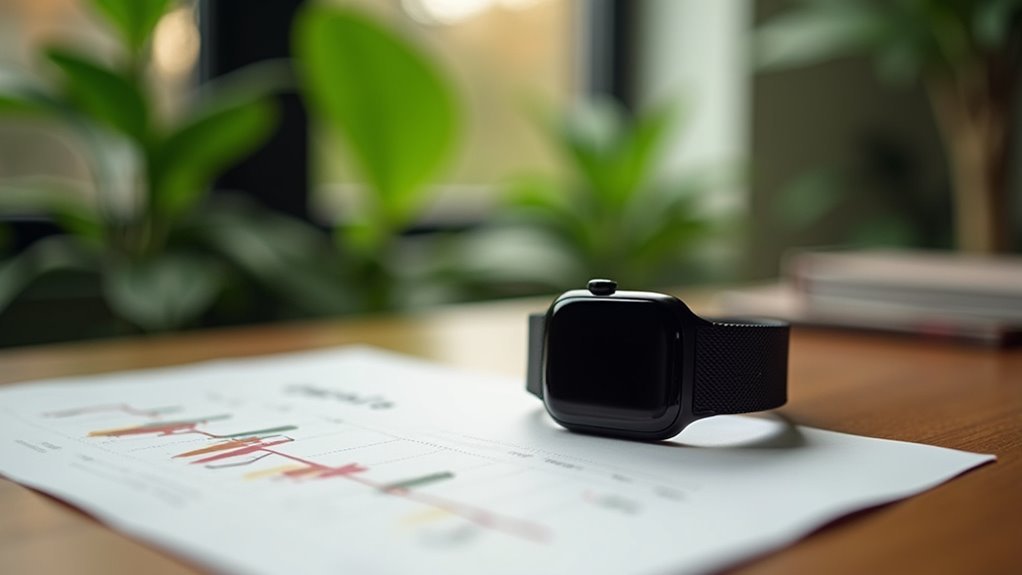
Behind every accurate stress reading on your wearable device lies a sophisticated technology called Heart Rate Variability (HRV), which measures the subtle variations in time intervals between consecutive heartbeats.
Your autonomic nervous system controls these variations—when you’re stressed, your sympathetic system activates and reduces HRV, while relaxed states increase it through parasympathetic activity.
Your body’s stress response operates through two competing systems—sympathetic activation that constrains heart rhythm variability, and parasympathetic relaxation that restores it.
Most wearables use optical sensors at your wrist to detect these changes, though chest-based ECG remains more accurate.
What makes HRV particularly essential is its sensitivity to both physical and psychological stress, often detecting changes before other crucial signs shift. High HRV indicates adaptability and resilience in the body, with individuals often experiencing less stress and greater happiness.
Your device processes this data through algorithms that distinguish between rest, stress, and recovery states, providing real-time feedback about your body’s stress response.
Skin Conductivity and EDA Sensors: Measuring Stress Through Physiological Response
While heart rate variability tracks your stress through cardiac rhythms, your skin tells an equally compelling story through electrodermal activity (EDA) sensors that detect the microscopic changes in your skin’s electrical conductance.
When you’re stressed, your sympathetic nervous system activates sweat glands, increasing your skin’s ability to conduct electricity. Modern wearables integrate EDA sensors into wristbands and smartwatches using stretchable, comfortable materials that monitor you continuously.
These sensors excel at identifying acute stress triggers through sudden conductance spikes and can differentiate between mental and physical stressors when placed on multiple body sites. Recent research has shown that finger placement provides optimal detection for mental activity-related stress responses.
You’ll receive real-time alerts based on your EDA patterns, giving you objective, quantitative stress markers for better self-awareness and intervention.
AI-Powered Personalized Stress Management Recommendations
When your wearable detects elevated stress through EDA sensors and heart rate variability, artificial intelligence transforms these raw physiological signals into personalized action plans that adapt to your unique stress patterns and lifestyle.
Your device learns your individual stress baseline, customizing notification thresholds to avoid unnecessary alerts while catching genuine stress episodes.
You’ll receive immediate, actionable recommendations—guided breathing exercises during meetings or meditation breaks when stress peaks.
The AI considers your calendar, suggesting ideal intervention timing that fits your schedule.
Smart scheduling integration ensures stress interventions arrive at optimal moments, seamlessly weaving wellness into your daily routine without disrupting productivity.
Machine learning algorithms continuously refine recommendations based on what works best for you, whether that’s specific breathing techniques or mindfulness routines.
This adaptive system evolves with your changing lifestyle, ensuring stress management remains relevant and effective. Advanced wearables integrate with telehealth systems to share stress monitoring data with healthcare providers, enabling remote consultation and reducing the need for frequent in-person visits.
Market Growth Projections: From $2.8 Billion to $5.3 Billion by 2035
You’re witnessing explosive growth in the stress monitoring wearables market, which has surged from $2.8 billion to $3.14 billion in 2024 and is projected to reach $5.3 billion by 2035.
This expansion is fueled by rising mental health awareness, telehealth integration, and advanced biosensor technology that’s making stress tracking more accurate and accessible. The market encompasses various device types including smartwatches, fitness trackers, smart rings, and chest straps that monitor psychological indicators through sophisticated sensors.
North America and Europe currently dominate revenue generation, but Asia-Pacific markets are positioning themselves as the fastest-growing regions for future expansion.
Current Market Valuation
The stress monitoring wearables market stands at a compelling inflection point, with current valuations ranging from $2.7 billion to $3.14 billion in 2024 across various industry reports.
You’re witnessing significant variance in these figures, reflecting the market’s rapid evolution and different methodological approaches analysts use to size this emerging sector.
What’s particularly striking is how quickly these valuations are shifting upward. Some sources project the market will reach $5 billion by 2025, representing a dramatic adjustment driven by accelerated adoption and technological innovation.
This growth reflects increasing consumer awareness of stress management’s importance and the integration of sophisticated monitoring capabilities into everyday wearables. The market landscape remains highly fragmented with numerous global and regional players competing for market share, including established tech giants and specialized wellness companies.
The valuation differences also highlight growing recognition of stress tracking’s penetration across both consumer wellness and medical device markets, positioning this sector for sustained expansion.
Projected Growth Drivers
Market analysts project stress monitoring wearables will nearly double in value over the next decade, climbing from $2.8 billion in 2025 to $5.3 billion by 2035.
You’ll see this growth driven by several key factors.
Rising mental health awareness is creating stronger demand for stress tracking devices. You’re likely noticing more people prioritizing wellness, and companies are responding with innovative biosensor technology and AI-powered insights that deliver actionable health data.
Major players like Apple, Fitbit, Garmin, Whoop, and Oura Health continue pushing technological boundaries with advanced features like heart rate variability monitoring and electrodermal activity sensors. Smart wearables are expected to capture 57% of the market share in 2025.
You’ll also benefit from expanding corporate wellness programs that integrate these devices, plus growing adoption among fitness enthusiasts seeking real-time stress management solutions.
Geographic Revenue Leaders
North America dominates the stress monitoring wearables revenue landscape, capturing the largest market share as the industry expands toward its projected $5.3 billion valuation by 2035.
You’ll find this leadership stems from high adoption rates and advanced healthcare infrastructure that supports wearable technology integration.
Europe follows closely, experiencing significant growth driven by strict health regulations and heightened consumer awareness.
If you’re tracking emerging opportunities, Asia-Pacific shows the most promising expansion potential due to increasing demand for health monitoring solutions across populous markets.
Latin America’s growth reflects expanding middle-class health consciousness, while you’ll notice more moderate progress in the Middle East and Africa, where economic factors influence consumer behavior and market penetration rates. The effectiveness of these devices depends largely on optical heart rate monitor accuracy, which forms the foundation for reliable stress assessment capabilities.
Wearable Vs Non-Wearable Devices: Comparing Continuous and Situational Monitoring
Understanding how wearable and non-wearable stress monitoring devices differ can help you choose the right approach for your lifestyle and monitoring goals.
Wearable devices provide continuous data collection, tracking heart rate variability and stress patterns throughout day and night. You’ll receive real-time analysis with immediate biofeedback, like guided breathing exercises when stress spikes occur.
These devices achieve impressive accuracy—the Oura Ring reaches 99.9% reliability against medical-grade ECG for resting heart rate.
Non-wearable monitoring offers flexibility through smartphone apps or standalone devices used during specific situations. You won’t need constant skin contact, making them less intrusive.
However, they miss daily fluctuations and nocturnal stress patterns that continuous monitors capture. Many wearables include features like guided meditations to help manage stress levels once they’re detected.
Your choice depends on whether you prefer thorough, ongoing insights or targeted, situational assessments without wearing devices consistently.
Integration With Meditation Apps and Wellness Platforms
Beyond choosing between continuous and situational monitoring, you’ll want to contemplate how well your stress monitoring device connects with your existing wellness routine.
The Oura Ring Gen 4 excels here, integrating with over 40 apps including meditation platforms, while providing personalized insights through its membership program.
Whoop 5.0/MG offers robust stress tracking that pairs effectively with mindfulness apps for holistic wellness management.
Apple Watch Series 9 seamlessly connects with Apple Health and various wellness platforms, making data sharing effortless.
These integrations aren’t just convenient—they’re transformative.
Your wearable’s heart rate variability data can guide breathing exercises, while stress alerts prompt mindfulness breaks.
The Lief AI Smart Patch utilizes HRV monitoring for stress management and offers biofeedback exercises to enhance your wellness routine.
When your device shares detailed stress patterns with meditation apps, you’ll receive personalized recommendations that adapt to your unique stress triggers and recovery needs.
Future Biosensor Advancements and Mental Health Awareness Impact
As wearable biosensor technology evolves rapidly, you’re witnessing a transformation that extends far beyond simple step counting or heart rate monitoring.
These devices are reshaping how society approaches mental health monitoring and treatment.
Future advancements will bring you:
- AI-driven predictive analytics that anticipate stress episodes before they occur, enabling proactive intervention strategies
- Novel biomarker detection through next-generation sensors that identify previously unmeasurable stress indicators
- Seamless EHR integration allowing your healthcare providers to access extensive mental health data for personalized treatment plans
- Cross-cultural adaptation ensuring stress monitoring features work effectively across diverse global populations
The shift from traditional subjective questionnaires to objective measurement technologies represents a fundamental advancement in mental health assessment accuracy.
You’ll benefit from normalized mental health monitoring that treats psychological wellness with the same rigor as physical health, reducing stigma while promoting broader public awareness and understanding.
Frequently Asked Questions
How Accurate Are Stress Monitoring Wearables Compared to Clinical Measurements?
You’ll find stress monitoring wearables show good correlation with clinical measurements for heart rate variability, but they can’t match lab-based cortisol tests or extensive psychological assessments for diagnostic accuracy.
Can Stress Tracking Wearables Help Prevent Anxiety Attacks or Panic Disorders?
You can’t directly prevent anxiety attacks with stress tracking wearables, but they’ll help you recognize early warning signs, practice breathing exercises, and identify triggers to manage stress proactively before it escalates.
Do Stress Monitoring Devices Work Effectively for People With Heart Conditions?
Yes, stress monitoring devices work effectively for you if you have heart conditions. They’ll continuously track your heart activity, help detect issues early, and enable better stress management, which is essential for your cardiovascular health.
How Long Does the Battery Last on Stress Tracking Wearables?
You’ll find battery life varies considerably across stress tracking wearables. Amazfit Band 7 lasts longest at 15 days, while Oura Ring provides 8 days, Garmin offers up to a week, Whoop manages 5 days, and Apple Watch requires daily charging.
Are Stress Monitoring Wearables Covered by Health Insurance Plans?
You’ll typically find stress monitoring wearables aren’t covered by health insurance plans unless there’s medical necessity. However, some employer-sponsored wellness programs might include them, and coverage varies considerably between providers.

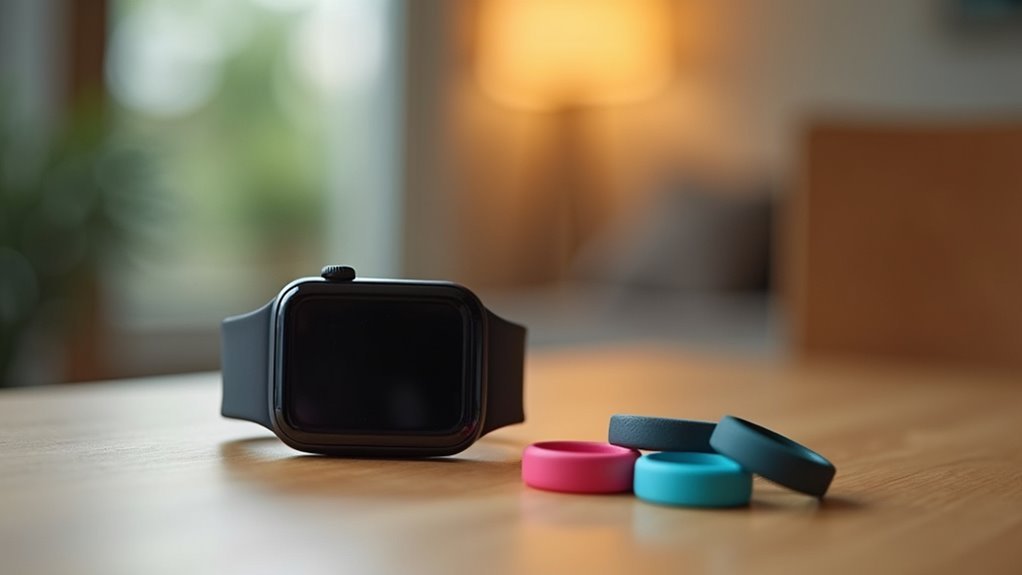
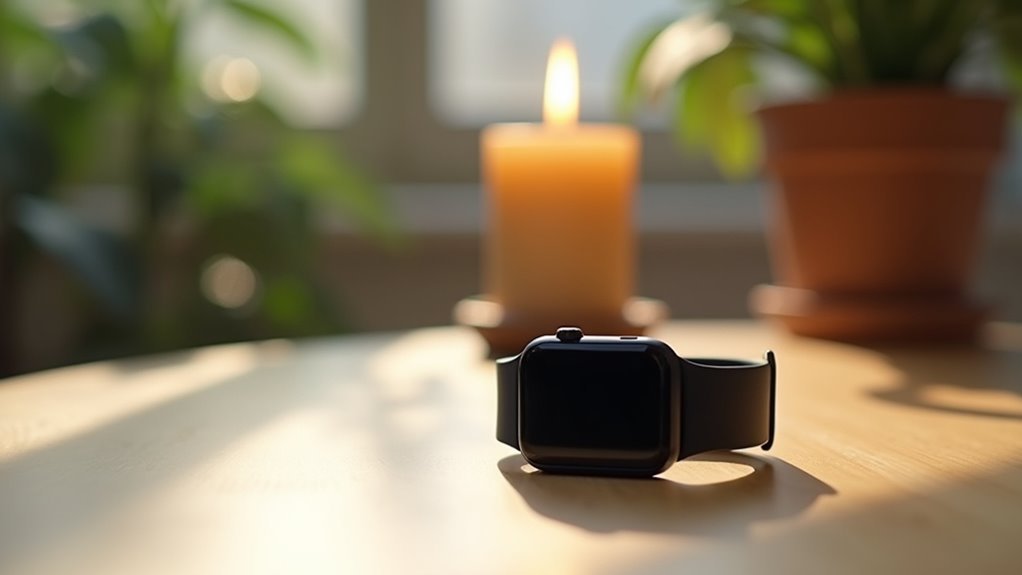
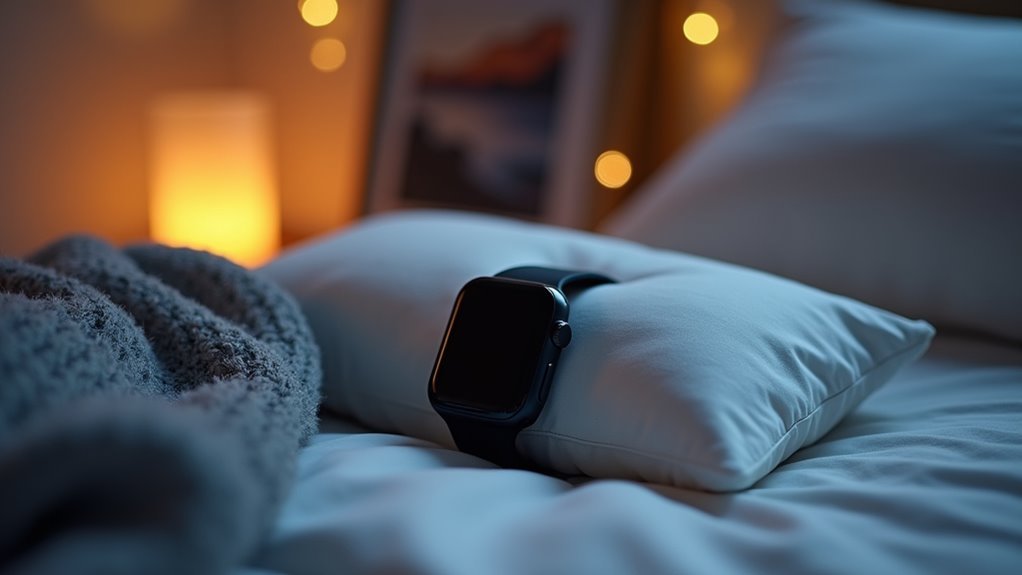
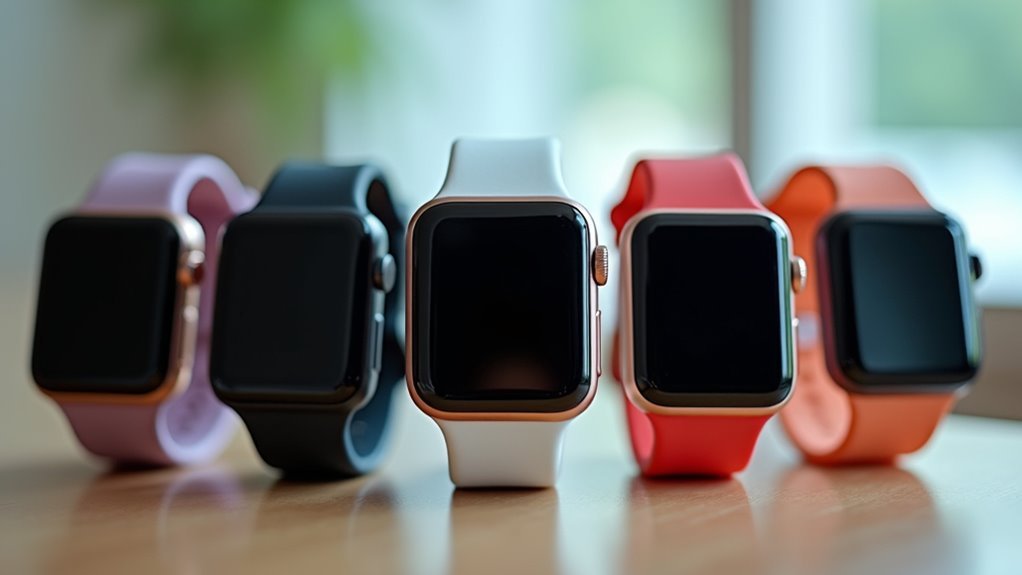
Leave a Reply